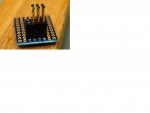Its not something i have given a lot of thought to, and this may have been asked many times...
Can a picaxe be programmed by another picaxe with the required program loaded into it?
Reason for the question is i have several remote circuits that from time to time i need to change the program in, all very simple other than the need to drag the laptop out and reprogram the chip, it be nice to dump the new program into a little picaxe circuit and simpy transfer the program across.
Can a picaxe be programmed by another picaxe with the required program loaded into it?
Reason for the question is i have several remote circuits that from time to time i need to change the program in, all very simple other than the need to drag the laptop out and reprogram the chip, it be nice to dump the new program into a little picaxe circuit and simpy transfer the program across.

